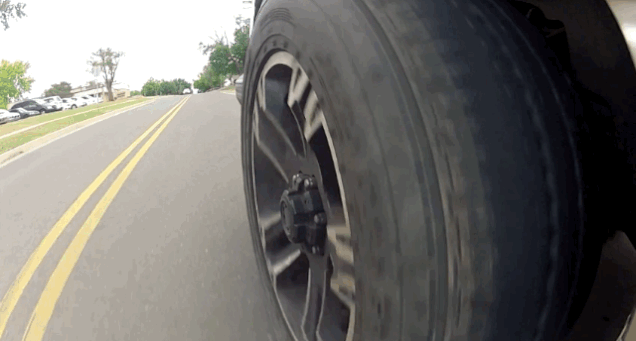Why Do Wheels Look Like They Rotate Backwards At A Certain Speed?

Whether it’s footage online, on the television or seen in the real world with the naked eye, a wheel seemingly defying the laws of motion has probably puzzled you at some point in your life.
Watch a wheel as it accelerates and the rotation will seem normal to begin with, turning in the direction of motion. Once it reaches a certain speed however, the spokes of the wheel can sometimes be seen to be stationery or even rotating in the reverse direction to travel. So what is going on?
This illusion is known as the ‘wagon wheel effect’ and it all comes down to the function of the human eye and the way in which our brain manages to interpret and process the images it is presented with. The human eye is capable of operating at frame rates upwards of 200 frames per second (FPS) when processing light but things work differently when it comes to detecting motion. Studies have shown that the human visual system can detect changes in motion - like a wheel spinning - up to only 13 FPS.
Although your eyes can detect frame rates higher than that, the brain can generally only compute and react to 10-15 images per second, although this figure can be increased with specific brain training and depending on which part of the eye is reporting back the information.
In terms of a car wheel, it’s best to concentrate on how the spokes are moving in relation to your visual system’s processing rate. Let’s say a wheel has four spokes at 90 degrees to each other and one spoke starts vertical at the 12 o’clock position. If the wheel moves slightly forward to the two o’clock position by the time the next frame is processed by your brain - the wheel will move forward in the direction of travel as per usual.
If, however, the wheel is turning at a speed that the spoke reaches a 90 degree interval around its rotation (three, six, nine or 12 o’clock) by the time the next frame is processed, your brain will be tricked into thinking the wheel has stayed stationery as the spokes look like they are in their original positions despite their rotation.
The reverse effect appears when the wheel reaches a speed that the 12 o’clock spoke has managed to rotate around to something like 11 o’clock. Your mind will then join the dots and come to the conclusion that the wheel has rotated backwards, which it then perceives as a smooth backward motion as it pieces the images together.
So instead of your mind interpreting the clockwise rotation to 11 o’clock, it will instead interpret an anti-clockwise rotation simply due to a lack of processing speed.

This also works when filming cars driving - if a camera is filming at 50 frames per second and the wheel is spinning such that it completes a full rotation every 1/50th of a second, the wheel will seem to be stationery. A wheel rotating reverse to the direction of travel must therefore be falling just short of a full rotation within that time slot, forcing your mind into the optical illusion.
The same applies to helicopter rotors, and aeroplane propellers. Your eyes may be awesome pieces of kit, but you can’t always trust what you see!
Comments
Our eyes work at 15 fps? What filthy casual post is this? XD
i have a dream, that one day we can have graphics card for our eyeholes
It’s just the inertia of the planet after you released the gas pedal of a fast car, like my honda civic
Hey you could always own these
Finally, I’ve genuinely been wondering about this for my whole life!
Steoboscopic effect, I work on it for the school
(Null)
Im not familiar with how the eyes work,so im not judging the article. However, the following fact is true and it holds for the optical illusion however the eye works. The illusion is called aliasing. Let’s say Fspinning is the wheel spinning frequency( spins per second~Hz) and Fsampling( is the image sampling frequency of the camera or frames per second ). In order to store data in the digital world , sampling has to happen. There is a theorem called Nyquist Theorem that can easily be proven that states : in order to recreate a signal perfectly the sampling frequency has to be at least twice the frequency of what is recorded. So in this case , Fsampling = 2*Fspinning . If it’s less that then the digitally stored signal is aliased, which means the true signal is lost. So in the first place the signal that arrives in our eyes is not the original , its wrong due to aliasing. Let’s say the eyes can process infinite frames per second , then still we wouldn’t see the true rotation of the wheels.
(Another example of this , is the sampling frequency of CD’s. You can see that the minimum sampling frequency is 44.1kHz which is almost twice the range of the frequencies the human ear can hear.)
It would all be relatively correct if we processed what we see like a camera, but we don’t. Our eyes don’t see the world frame by frame, and our brains don’t process information frame by frame. The 200 fps, 13 fps, 30 fps, 60 fps or what ever that gets quoted around isn’t how our brains are actually working. It’s a comparison, as in if the rate of information processing was converted to video, it would be equal to X frame rate.
The reason given is pretty much why it appears to go backwards on video, but it only happens on video for the most part. The only way you can get this effect to happen while looking at a wheel in person, is if there is something that interrupts your vision for a brief moment. If the car is traveling behind a picket fence that has caps, or if you humm really hard.
Video does this easily, because everything is being shown frame by frame, picture by picture. The human brain will blurr images together if they are moving to quick, causing them to move smoother than jumping forward due to moving to fast for your brain to process.
human eyes can only see up to 30 fps
Pagination